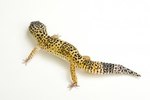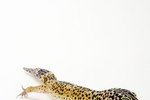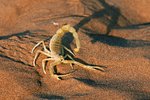Things You'll Need
10-gallon aquarium
Sterilized play sand
Rocks
Driftwood
Heat lamp
Thermometer
Fluorescent light
Water dish
Plastic hiding box
Crickets
Mealworms
The sagebrush lizard (Sceloporus graciosus) is a small lizard commonly found throughout the western United States. Adult sagebrush lizards grow no more than 5 inches long from the tips of their noses to the ends of their tails, making them easy to keep in small aquariums. Sagebrush lizards are brown to gray in color and typically have light-colored patterns running the length of their bodies. As their name suggests, sagebrush lizards are often found around sagebrush plants in the wild, which they climb and hide in during the day. Sagebrush lizards are easy to raise in captivity when you provide them proper housing and care.
Locate the aquarium in a quiet location in your home where the temperature remains constant throughout the day. You can keep sagebrush lizards in aquariums outdoors as long as they are not in direct sunlight and the temperature remains between 65 and 80 degrees through the day.
Fill the base of the aquarium with 3 to 4 inches of sterilized play sand and landscape the terrain with rocks to create hiding spaces and give the aquarium a natural appearance.
Place driftwood in the enclosure to provide areas for sagebrush lizards to climb. Securely situate the driftwood in the sand and ensure that it cannot fall over and injure your lizard.
Place a heat lamp over one end of the aquarium. You can place a heat lamp directly on top of the aquarium if it has a mesh top, or clip the heat lamp to the side of the aquarium if there is no top. Ensure that the heat lamp is shining over a piece of driftwood as well as rocks in the substrate to create a suitable thermal gradient with multiple temperature ranges for sagebrush lizards to bask in.
Place a thermometer under the heat lamp and measure the temperatures of the basking sites. Sagebrush lizards require a basking temperature between 85 and 90 degrees throughout the day; it's OK for temperatures in the enclosure to drop down to 65 to 70 degrees at night.
Place a florescent lamp with a full-spectrum reptile bulb over the enclosure. Keep the light on a 12 hour light cycle to provide sufficient ultraviolet light, which sagebrush lizards need to properly metabolize vitamins and minerals in order to develop healthily in captivity.
Fill a small water dish with dechlorinated freshwater, and ensure there is always clean water available for sagebrush lizards in their enclosure.
Place a small lizard hiding box in the enclosure on the opposite side of the tank from the heat lamp. Sagebrush lizards are active lizards during the day but need a sheltered area to hide at night in order to feel safe and secure in captivity.
Offer young sagebrush lizards pinhead crickets once each day. Feed the lizard only one or two crickets at a time to ensure that it actually eats the cricket. As the lizard grows, change the diet and feed adult crickets and mealworms two to three times each week.
Tips
Feed crickets and mealworms tropical fish flakes and dark greens such as kale, collard greens or mustard greens for 24 hours before feeding your sagebrush lizard so that the lizard gets a rich dose of vitamins with each feeding.
Dust crickets and mealworms with a reptile vitamin supplement every other feeding to provide the supplemental nutrients needed for healthy bone development.
Remove any uneaten food in the enclosure after 24 hours to prevent injury to your sagebrush lizard. Crickets and mealworms left in the enclosure can severely damage sagebrush lizards with their chewing mouth parts.





